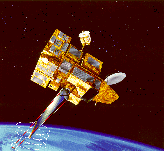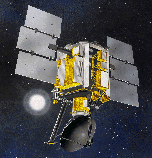

| News | |
| QuikSCAT | |
| NSCAT | |
| YSCAT | |
| SAR Research | |
| SCP | |
| CERS | |
| Publications | |
| Software | |
| Studies | |
| Lab Resources | |
| Group Members | |
| Related Links | |
| Contact Us | |
| Getting to BYU | |
The SeaWinds ScatterometerSeaWinds on ADEOS-II 
SeaWinds on QuikSCAT

The SeaWinds scatterometer flew on QuikSCAT (1999-) and ADEOS-II (2002). The slightly modified engineering model flew on the ISS (2014-2016). By JPL convention SeaWinds on the QuikSCAT mission is known as QuikSCAT, while SeaWinds on ADEOS-II is known as SeaWinds. The modified SeaWinds on the ISS is known as RapidSCAT. SeaWinds on ADEOS II (127K gif)and SeaWinds on QuikSCAT (101K gif) are follow-on missions to the successful NASA Scatterometer (NSCAT) mission. SeaWinds is a scanning dual pencil-beam Ku-band scatterometer. SeaWinds on ADEOS II operated for nine months aboard ADEOS-II until the satellite power system failed. SeaWinds on QuikSCAT was a fast-track SeaWinds instrument flying on a dedicated spacecraft. SeaWinds was successfully launched in June 1999 aboard the QuikBird spacecraft atop a Titan launch vehicle (144K gif). QuikSCAT Logo (101K gif). Additional animated images are available from the QuikSCAT Movie page. RapidSCAT is a slightly modified SeaWinds flying on the International Space Station (ISS) that was launched in Aug. 2014. The instrument ceased working when its ISS power adapter failed after nearly two years of operation. The RapidSCAT modifications included a different antenna to provide a larger beamwidth and larger incidence angles. The transmit/receive timing was also altered to account for lower altitude operation from the ISS compared to QuikSCAT and ADEOS-II for which SeaWinds was designed. Selected SeaWinds ProjectsX-Factor Students in the MERS lab wrote the software to compute the so-called "X"-factor used in computing sigma-0 from the power measurements. The resulting code and tables were used by JPL for processing QuikSCAT and SeaWinds data. This work was extended to compute the measurement spatial response function, which is used for reconstruction and resolution enhancement. Code to compute the response function is availble from MERS software page. Iceberg Tracking with SeaWinds on QuikSCAT data SeaWinds is designed to measure ocean winds (299k Quiktime movie), but is useful in many other applications. One of the more innovative new applications is in iceberg tracking. Shortly after instrument turn on in early July, 1999, QuikSCAT located a massive iceberg, later identified as B10A, floating in the Drake Passage between South America and Antarctica. Its location was relayed to the National Ice Center who issued a shipping advisory on the story. JPL issued a Press Release on the story. The 38 km by 77 km iceberg was first spotted in an enhanced resolution image (157K gif) produced by Dr. Long from QuikSCAT data using the SIRF algorithm. He also generated an animated movie [JD 194-276 (455K mpeg)] [JD 200-298 (300K AVI)] [JD 200-298 (372K QuikTime)] [JD 200-298 (4MB QuikTime)] of the iceberg movement. Each image in this movie was produced with one day of QuikSCAT data. Other images of this iceberg have been collected from satellite sensors, for example, a Radarsat SAR image (125K jpg), DMSP OLS (686K jpg) and LandSat image (196K jpg) (closeup 115K jpg) (from the National Ice Center web site). The National Ice Center is a branch of the National Oceanic and Atmospheric Administration (NOAA)). The UMET office out of the Falklands recently flew an aircraft to make observations (156K gif) of the iceberg. In early October, 1999, B10A was joined by another superberg, A22B (12 NM x 35 NM), in the Drake Passage. A22B originally calved from the Ronne Iceshelf in 1986 and has been floating in the Weddell Sea until just recently. It can be seen moving northward in the QuikSCAT movies [JD 200,1999 - 098,2000 (3MB mpeg)] [JD 200,1999 - 098,2000 (3.8MB QuickTime)] [JD 274,1999 - 098,2000 (8.9MB AVI)] . Each image in this movie was produced with one day of QuikSCAT data. An AVHRR visible image (2.1MB) from Oct. 13, 1999 shows both icebergs. On January 11, 2000 B10A broke up in at least two smaller pieces while it was just west of South Georgia Island. A22B, an equally large iceberg is nearby. An image (4MB gif) image shows a time sequence of enhanced resolution scatterometer observations of B10A's break up on JD11, 2000 near South Georgia Island in the South Atlantic. A22B is nearby. The image consists of 6 rows of images with time running to the right. For each day there are two images, one morning and one evening. The top row images were created from SeaWinds 13.5 GHz V-pol 'eggs' using the SIR resolution enhancement algorithm. The pixel resolution is ~2.225 km. The second row was created from SeaWinds 13.5 GHz H-pol 'eggs'. The last rows were created from 'slices' measurements using the SIRF resolution enhancement algorithm while the center rows were done with the AVE algorithm. Note that the intrinsic resolution of the SeaWinds sensor is approximately 7x25 km but is improved with the algorithms. Since the algorithms tend to have artifacts over the ocean, seeing all the versions can be helpful for interpretting the images. The ocean appears dark when the wind speed is low and lightens for higher wind speeds which accounts for the lightening and darkening of the images. Generally, glacial ice shows up brightly against the ocean, but can be hid when the wind speed is high. The images show that on JD9 B10A is in one piece but that by JD12 it is clearly in multiple pieces. The demise of B10A and A22B just NW of South Georgia Island can be seen in the the following animations: [JD 1-128, 2000 (1.6MB mpeg)] [JD 1-128, 2000 (3.5MB QuickTime)] [JD 1-128, 2000 (12.4MB avi)]. A longer time series of these movies can be seen in [JD 1-221, 2000 (34.5MB avi)] [JD 1-221, 2000 (37.7MB animated gif)] [JD 1-221, 2000 (4.8MB mpeg)] [JD 1-221, 2000 (5.5MB QuickTime)]. An ascii file (11k) containing the positions of the icebergs from JD200, 1999 through their demise is available. The calving and motion of major icebergs in the Weddell and Ross Seas of Antarctica can be seen in these animations: (these have been reduced in resolution for easier download and viewing) [Weddell Sea JD 137-225, 2000 (14.4MB avi)] [Weddell Sea JD 137-225, 2000 (15.2MB animated gif)] [Weddell Sea JD 137-225, 2000 (1.5MB mpeg)] [Weddell Sea JD 137-225, 2000 (3.0MB QuickTime)] and [Ross Sea JD 90-226, 2000 (16.8MB avi)] [Ross Sea JD 90-226, 2000 (50.9MB animated gif)] [Ross Sea JD 90-226, 2000 (4.0MB QuikTime)]. The dynamics of both the sea ice motion and major icebergs are clearly evident. Sea Ice Extent from SeaWinds on QuikSCAT data Besides tracking icebergs QuikSCAT data has been very useful in other polar ice studies. A key application is sea ice extent mapping. Sample results (1.1MB gif) from applying Remund and Long's ice edge detection algorithm for Antarctica to QuikSCAT data illustrate the resolution of the processed data. A [JD 200-266 mpeg movie (366K)] [JD 200-350 AVI movie (1MB)] [JD 200-350 QuikTime movie (1.25MB)] of ice-masked images is available. (In the movie, white areas in the sea-ice are due to missing scatterometer data.) The full QuikSCAT data set has been processed this way, resulting in a decade-long data set (Remund and Long, 2015). This has been augmented with OSCAT data (Lindell and Long, 2016). The resulting product is available from the Scatterometer Climate Record Pathfinder (SCP) web page. QuikSCAT Data Products Under the direction of Dr. Long, the MERS lab have produced a series of standard image products from SeaWinds data. Some of these products are described in the MERS QuikSCAT Products home page, with the complete data set available through the Scatterometer Climate Record Pathfinder (SCP) web page. QuikSCAT Calibration Ground Station A specialized calibration ground station (CGS) was developed to aid in the calibration of SeaWinds. BYU was involved in the development and analysis of the QuikSCAT CGS and operated this ground station for many years. Further information is available here. CGS Publications
RapidSCAT The RapidSCAT scatterometer consists of the slightly modified SeaWinds engineering unit flown on the International Space Station (ISS). Unlike all other scatterometers which operated in a sun-synchronous orbit, the ISS orbit was non-sun-synchronous which enabled RapidSCAT to study the variations in surface backscatter versus local time of day, see A.P. Paget, D.G. Long, and N.M. Madsen, "RapidScat Diurnal Cycles Over Land," IEEE Transactions on Geoscience and Remote Sensing, Vol. 54, No. 6, pp. 3336-3344, doi:10.1109/TGRS.2016.2515022, 2016 and N.M. Madsen and D.G. Long, "Calibration and Validation of the RapidScat Scatterometer Using Tropical Rainforests," IEEE Transactions on Geoscience and Remote Sensing, Vol. 54, No. 5, pp. 2846-2854, doi:10.1109/TGRS.2015.2506463, 2016. Following up on their earlier work on the SeaWinds X-factor, BYU MERS students modified SeaWinds X-factor code to find ways to compute the RapidSCAT X-factor, create X-factor tables that could be used with the SeaWinds code. MERS students also participated in system calibration (Madsen and Long, 2016).
Selected MERS SeaWinds and QuikSCAT Publications The MERS laboratory has been involved in the design analysis of the SeaWinds system in support of JPL. Several papers and reports have been generated. Some sample papers include: (More MERS publications)
|